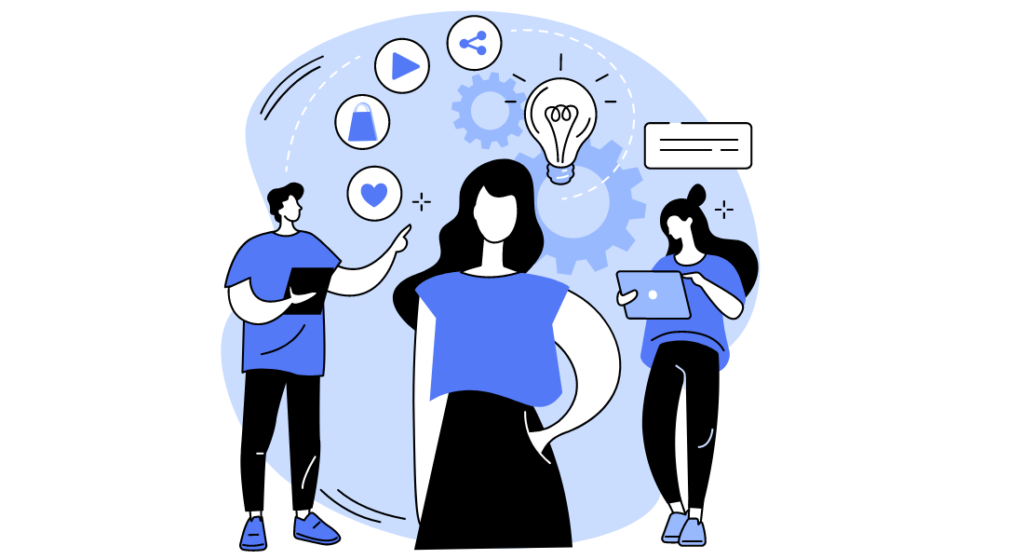Table of Contents
- Executive summary
- The challenge of continuous listening
- New strategic use of surveys
- Translational vs. Applied Behavioral Science
- Concluding remarks
Executive summary
Since 2020, we have been observing a new phenomenon in the employee experience space. As organizations increased the frequency of connecting with their workforce via surveys, they have found it particularly challenging to action their surveys with the same frequency. So far, one of the key approaches to counteract this has been automation, to free up time for action planning and implementation.
However, automation has only been a partial solution as many organizations still report they either do not take action based on surveys as often as they wish, do not survey as often as they wish because they know they won’t be able to take action, or they simply wish the actions they did take were more effective.
In this article, we discuss a less explored idea, and that is using the survey itself as a catalyst for change. In the following sections, we will describe, with examples, how questions on surveys can be used to change the way employees think about certain topics, how much they think about them, as well as their future behavior.
We believe this has great potential to result in a more efficient use of resources for increased impact. In fact, surveys are already being used in this way in other domains, such as consumer experience, and a few organizations are already experimenting with this new use of surveys for their employees. The key will be in more organizations adopting this new way of using surveys, using it with confidence, and of course, using it ethically.
The challenge of continuous listening
Over the last two years, we have seen an accelerated adoption of continuous listening using employee surveys. Whereas before 2020, organizations often asked their employees to complete a survey about any aspect of their work experience, such as engagement, culture, or professional development, about 1-2 times a year at best, over the course of 2020 and 2021, companies have increased the number of times they checked in with their employees to up to 6 times as many, using shorter and more focused approaches known as pulse surveys.
Having a more frequent and ongoing dialog with their employees seemed like the exact right thing to do for organizations that deeply cared about their workforce. However, one of the key struggles companies have experienced as they increased the frequency with which they survey their employees, has been acting on survey insights with the same frequency as they collect the data. This was true even for companies that used to be quite good at actioning their survey data.
Arguably, without action, there cannot be change, rendering those particular data collection activities quite difficult to justify. To make matters worse, employees can and do notice when no action is being taken, becoming more reluctant to participate in further surveys – a vicious circle that is unlikely to lead to more or better action being taken.
One of the key challenges for why companies cannot take action on the great volume of data is that they don’t have sufficient time. Many have tried to counteract this paradox of collecting more and more data but being less able to take action on it, with automation. Integrating with HRIS systems is one example. Today it is much easier to survey every employee as soon as they join the company in real-time, making the data even more relevant. If Human Resources and People Analytics teams had more time, they could better focus on taking action, which will drive results. While this strategy has helped some, particularly for those steps of continuous listening that tend to involve a lot of repetition: data collection, data analysis, and reporting, many companies still struggle with taking action on the insights they get via continuous listening. Even automation was most often not enough to provide sufficient time and capacity for HR teams to take appropriate action on all the new data available to them.
So, does this leave us in a place where the only answer is to go back and do fewer surveys? Before we agree on the best course of action, we would like to explore one more strategy: how surveys can be used as a catalyst for change and a way to nudge employees into changing their behavior.
New strategic use of surveys
A growing body of research suggests that the mere act of answering questions on a survey can and does change the future behavior of people taking the survey. These phenomena have been known in behavioral sciences under various names: the Hawthorne effect, survey-behavior effects, nudges, push polling, or simply survey effects, each one referring to slightly different mechanisms through which surveys come to influence future behavior.
The use of survey questions to change behavior has been observed in other disciplines, such as customer experience surveys, much more so than employee surveys. Given that the number of surveys deployed wouldn’t change per se, and only how the questions are written would change, we believe that this could be a worthwhile endeavor for organizations to try out and see if they can achieve some change through survey deployment itself. In their quest for creating a more satisfying employee experience and a more engaged and fulfilled workforce, Human Resources and People Analytics teams can use surveys to try and leverage these mechanisms to their (and their employees) mutual advantage. Below, we detail five of these mechanisms along with examples of how they can be used in a workforce context.
1. Being presented with new information

The best way to influence behavior, and the least controversial, is by genuinely convincing someone of a particular course of action
Concretely, with employee surveys, there is an opportunity to ask questions and collect data, but there is also an opportunity to present new information, explain a particular context, and convince employees; whether it be of a new initiative, the strategic importance of a particular aspect of company culture, or of adopting innovative technology. Of course, surveys cannot be the main avenue of communication, but they can complement and enhance existing ones.
For example, if the company is deciding to re-engineer its culture around new corporate values, it can serve, as they communicate commitment to those values, to ask employees via a survey how much they personally identify with each one. This can not only help an organization gauge how well employees already adhere to those values, but it can also make it more likely that employees will better remember those new values in the future, regardless of their particular answers on the survey.
How so? This is known in the psychology literature as the depth of processing effect. The more in detail one thinks about something, the better that information is embedded into memory, making it more likely to be remembered in the future. Using the example above, thinking about how new corporate values apply to you personally requires more in-depth processing than listening in on a meeting where someone else is talking about the new values; hence, it will likely lead to better memory.
2. Being presented with information framed in a way that aligns with strategic interest

People will prefer an uncertain outcome (change) over a certain one (status quo) if the focus is on what they stand to lose.
Behavioral economics and prospect theory teach us that, when left to their own devices, people prefer a certain if smaller gain, over a larger but uncertain one. This can lead employees to prefer the status quo even when change is very much in their best interest. This can be particularly counterproductive if an organization is strategically committed to change, because employee buy-in can very much determine any initiative’s success.
Fortunately, we also know how information is presented plays a critical role. And in fact, people will prefer an uncertain outcome (change) over a certain one (status quo) if the focus is on what they stand to lose. Organizations can use this as they guide their employees toward choices.
For example, if it’s of strategic importance for an organization to increase diversity, but at the same time, diverse candidates are perceived as the “risky” choice by hiring managers, it will help to refocus the conversation on the certain future loss of continuing the status quo (of great talent and of innovation potential) versus the actually uncertain loss if one individual hiring decision that favors a diverse candidate does not result in a good outcome (because it could very well result in an excellent outcome).
Communication in an organization goes well beyond surveys. However, one should not forget about the capacity of surveys to help reinforce the communication of strategic interest and increase the chances that a particular choice will be favored when the time comes, which leads us right into the next behavior-influencing mechanism.
3. Being asked to declare an intention to engage in a particular behavior

Asking people a hypothetical question or asking them to make a prediction of how they will behave in the future, can make them more likely to later behave in line with what they committed to.
A particularly interesting effect of being surveyed is that asking people a hypothetical question or asking them to make a prediction of how they will behave in the future, can make them more likely to later behave in line with what they committed to.
There is a powerful example of this from the US Government during the Obama administration in 2015, which was also featured in The New York Times. A seemingly small modification on a tax form – placing the signature box and statement where people commit to reporting honestly at the beginning of the form – resulted in the Government gathering a significantly larger amount of taxes they were owed compared to using the version of the form where the signature box was placed at the end.
Virtually all companies have policies that require employees to behave in particular ways, for example, non-discrimination policies. Employees are typically asked to sign an acknowledgment of these policies during onboarding. What if the surveys employees have to fill out, such as the onboarding survey that comes one month after people’s entry date, or the annual culture survey, were used (in part) to further reinforce people’s commitment to abide by important company policy?
4. Self-persuasion
This powerful mechanism has been used with great success in educational contexts to increase the likelihood that students from an underrepresented background (Black, Latino, or first-generation college students, for example) will successfully complete their education.

A message of encouragement improved retention of students from disadvantaged backgrounds by 9-10% and resulted in a .19 points increase in first-year GPA.
Typical interventions consist of personal stories from an upper-year student or an alum with the same background that celebrate their success and provide examples of how they overcame their own challenges, which resources were helpful, etc. These stories will often portray challenges as normal and temporary, and are featured on college websites to increase a sense of belonging among students from the same background, normalize the idea that they can be successful, and increase recruiting and retention. The approach has recently become popular in an employment context as well.
A crucial element for these interventions working is getting the person reading the story to better internalize its message. This is why many successful interventions in an educational setting actually happen before publishing a story on a website and include an element of self-persuasion. After reading a story or being presented with it in the context of an event, students are asked to craft a message of encouragement to a future student like them to assuage their concerns about belonging. In one particular example, this has been shown to improve retention of students from disadvantaged backgrounds by 9-10%, along with a .19 points increase in first-year GPA.
As companies experience greater turnover and double down on their DEIB efforts to retain their diverse workforce, this element of self-persuasion is great to include as an open-ended question in the typical survey after a corporate DEIB workshop or (why not) their annual culture survey.
5. Reflecting on one’s emotions
Emotional intelligence is a topic that continues to garner much attention in the workplace, especially when it comes to leadership. An important component of emotional intelligence is seeing things from a different angle when emotions run high. This changes the way a negative emotion is experienced and can reduce not only its overall intensity, but also the negative consequences associated with it.

An important component of emotional intelligence is seeing things from a different angle when emotions run high.
While some of us are naturally more inclined to reflect on our emotions, this is absolutely a skill that can be built over time, and it can also be influenced situationally. A large body of evidence by Pennebaker and colleagues suggests that expressive writing has the power to reduce depression, anxiety, muscle tension, pain, and a number of stress indicators.
Employee surveys are absolutely one of the tools at our disposal if the problem is, for example, reducing the intensity of negative emotions associated with one’s job, one’s manager, or the company in general. Qualitative survey analysis is gaining in popularity in HR and People Analytics circles to draw insight, but in addition to analyzing the open-ended answers, allowing employees to provide these answers can help change their emotional mindset and state. Of course, it’s critical to pose the question in such a way that employees take the time and put in the effort to answer.
Translational vs. Applied Behavioral Science
Behavioral scientists working on Human Resources and People Analytics teams will be quick to note that any behavioral nudges they design will have more impact when their role goes beyond translating scientific theory into potential applications. To make nudges even more effective, it’s valuable to test them before deploying them at scale. For larger organizations, it is relatively easy to employ A-B testing and be able to track which kind of nudges have an impact that is aligned with the organization’s culture and key initiatives.
Putting nudges to the test is important. Translating laboratory-based research into real-life applications does not always ensure the expected effects when it comes to behavior. The original research that the nudge is based on may have been conducted in a different context. For example, working adults in their 40s might not process information in the same ways that college students will, attenuating the expected effect of a nudge. While a theory may look promising based on laboratory evidence, testing it inside your own organization is important.
Some of what determines which outcome is more likely has to do with the person, and some of it has to do with the specific situation the person is in outside of taking the survey, for example, whether they have the extra five minutes it takes to run to the healthy take-out place or the extra five dollars. These situational factors can be hard to control and hard to anticipate, so the best nudges are those that have been tested as close as possible to the context they will be deployed in.
Concluding remarks
Hopefully, our message is clear that, in addition to using employee surveys to collect data, companies can also use surveys to influence or nudge behavior. By looking ahead and incorporating this focus on behavior change into their survey strategy, companies can make it more likely that their initiatives, whether based on survey data or not, have a positive impact. Some companies already do so successfully. As more begin to make use of behavioral science to breathe new life into their continuous listening programs, we expect to see a few new trends in the employee survey space:
- More thought will be put into crafting the right survey questions, with companies re-considering how the moderate gains from using an approach based heavily on templates actually stack up against the impact opportunities they are missing on in terms of helping to shape important employee behaviors and with that, their company’s entire employee experience.
- Behavioral science expertise will gain more appreciation in Human Resources and People Analytics teams, and demand for internal as well as external talent with this valuable expertise will increase.
- HR and People Analytics teams will become more comfortable with experimentation and evaluating everything from survey questions to more elaborate interventions designed based on data insights against a predefined set of people & business outcomes.
Lastly – and we kept this at the end specifically because we think it’s an important consideration that should remain top-of-mind for our readers – there are ethical implications around the idea that companies can help employees make choices that are in the employees’ best interest and that employees otherwise would not make for themselves. The two notions should very intentionally be challenged rather than assumed.
To do so, practitioners should continuously examine whether the choices or behaviors they are trying to influence are actually in the employees’ best interest rather than (or in addition to) the interest of the company they work for. And it would serve everyone well to establish data in hand, whether these are, in fact, choices employees would not make or behaviors they would not enact if left to their own devices.


